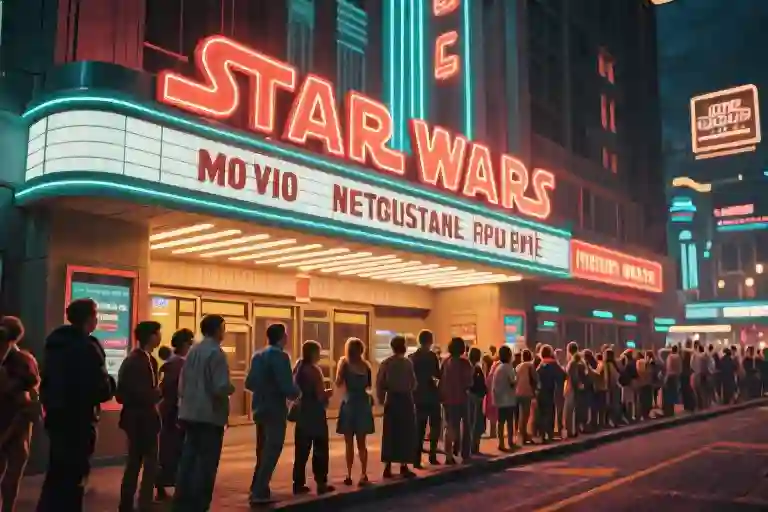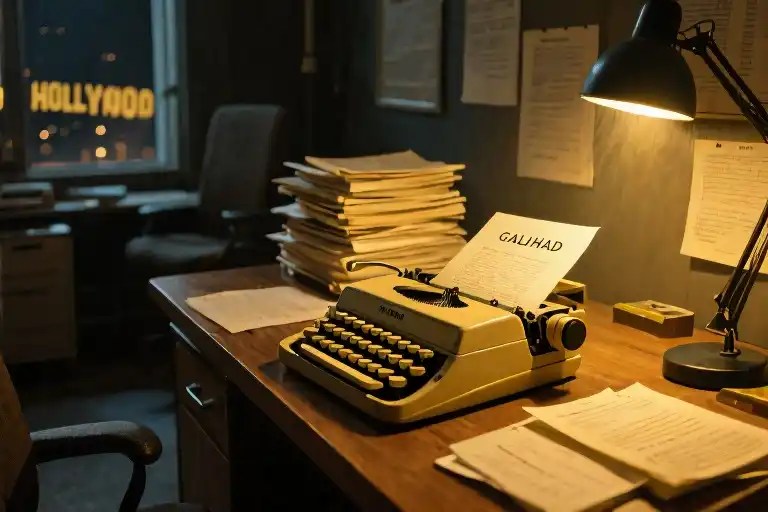The year was 1977, and science fiction cinema stood at a crossroads. Theater marquees told the story – low-budget B-movies with rubber-suited aliens dominated the genre, accounting for less than 5% of total box office receipts. These films played to niche audiences in drive-ins and midnight showings, often dismissed as childish fantasies or bleak dystopian warnings. Then came May 25th, when a scrappy little space adventure called Star Wars premiered at 32 theaters across America.
Nobody expected much from George Lucas’ passion project. Studio executives had fretted over its $11 million budget (modest by today’s standards but risky for an unproven sci-fi concept). The cast included relative unknowns like Mark Hamill and Carrie Fisher. Early test screenings left some executives baffled by terms like “the Force” and “Jedi Knights.” Yet within weeks, lines stretched around city blocks as Star Wars shattered records, eventually grossing $775 million worldwide – making it the highest-grossing film until that time.
What happened next rewrote the rules for science fiction. Star Wars didn’t just succeed – it fundamentally altered how audiences engaged with the genre, how studios produced speculative stories, and how creators approached worldbuilding. This wasn’t merely a hit movie; it became a cultural weathervane pointing toward three seismic shifts:
First, the film demolished barriers between “serious” cinema and genre entertainment. Before Star Wars, science fiction often wallowed in existential dread (think 2001: A Space Odyssey) or campy monster fare. Lucas blended Joseph Campbell’s mythological frameworks with Saturday morning serial energy, creating something both weighty and wildly entertaining. Families who’d never considered watching a spaceship movie found themselves debating lightsaber colors over dinner.
Second, Star Wars proved science fiction could be commercially viable beyond ticket sales. The Kenner toy company’s $100 million in action figure sales during 1978-79 – more than eight times the film’s production budget – revealed an untapped market. Suddenly, studios saw sci-fi not just as films but as merchandise pipelines, theme park attractions, and multimedia empires.
Finally, the film’s narrative DNA began replicating across entertainment. That perfect cocktail – the farmboy hero, the wise mentor, the ultimate weapon – became storytelling shorthand for an entire generation of creators. From James Cameron’s Avatar to the Marvel Cinematic Universe, traces of Lucas’ formula appear wherever heroes journey from obscurity to destiny.
As we examine these impacts in detail, remember: Star Wars arrived at precisely the right cultural moment. Post-Watergate America craved clear moral binaries. Advances in special effects could finally realize Lucas’ vision. And perhaps most importantly, audiences were ready to believe again – not in perfect futures, but in the possibility that even in a galaxy far, far away, hope could triumph.
From Basement Screenings to Living Room Blockbusters
Before Star Wars burst onto the scene, science fiction lived in the cultural margins. The genre thrived in dimly lit basement screenings at university film clubs, discussed passionately by small groups of devoted fans who could quote Asimov’s laws of robotics but rarely saw their favorite stories on multiplex screens. Most sci-fi films of the early 1970s carried the faint odor of B-movie bargain bins – low-budget affairs about bug-eyed monsters or dystopian warnings shot in washed-out technicolor.
Then came May 25, 1977. When Star Wars opened in 2,300 theaters across America, it didn’t just sell tickets – it rewrote the rules of what science fiction could be. Suddenly, families lined up around city blocks, children clutching their parents’ hands while teenagers debated light saber colors. The film’s $7.7 million opening weekend (equivalent to $35 million today) wasn’t just impressive – it was revolutionary for a genre that had never been considered mainstream entertainment.
What changed? Star Wars brought warmth to a genre that had grown coldly intellectual. Where 2001: A Space Odyssey asked audiences to contemplate human evolution during its glacial space ballet sequences, Star Wars gave us a hotshot pilot winking at the camera as he blew up planet-killing weapons. The film’s secret weapon wasn’t its special effects (though those dazzled), but its emotional accessibility – a space fantasy that played like a Saturday morning serial served with fresh popcorn.
The numbers tell the story best. Within five years of Star Wars’ release, membership in science fiction fan clubs tripled nationwide. The annual World Science Fiction Convention saw attendance spike from 3,500 in 1976 to over 15,000 by 1982. Most tellingly, a 1978 MPAA study found that family groups (parents with children under 12) now comprised 43% of sci-fi film audiences – up from just 6% in 1975. Science fiction had escaped its niche.
This cultural shift rippled through the industry. Studios that once greenlit maybe one or two sci-fi projects per year suddenly couldn’t get enough. The 18 months following Star Wars saw the release of Close Encounters of the Third Kind, Superman, and the Star Trek film revival – all major studio investments that would have been unthinkable before Lucas’s gamble paid off. Even the language changed; theater owners began reporting “Star Wars numbers” when describing unexpected box office successes.
Perhaps the most enduring legacy was how Star Wars made science fiction communal. No longer just the domain of solitary readers or midnight movie cultists, the genre became something shared across generations. Fathers who grew up with Flash Gordon serials found common ground with sons obsessed with X-wings. The basement door had been kicked open, and science fiction would never retreat to those shadows again.
When Science Met Myth: The Genre Transformation
The late 1970s presented an odd paradox for science fiction. While novels like Dune explored complex socio-ecological themes, cinema screens were dominated by dystopian nightmares like Soylent Green or Logan’s Run. These films, often low-budget productions, treated futuristic settings as backdrops for societal collapse narratives. Audiences associated sci-fi with bleakness – until a farm boy from Tatooine changed everything.
What made Star Wars revolutionary wasn’t just its special effects, but its deliberate rejection of hard science fiction conventions. George Lucas took the clinical accuracy of 2001: A Space Odyssey (1968) and replaced it with something far more primal: myth. The Force became this universe’s magic system, lightsabres turned into Arthurian swords, and the Death Star transformed into an evil wizard’s tower. This wasn’t science fiction as NASA might envision it; this was The Lord of the Rings with blasters.
The shift manifested in three fundamental ways:
1. From Laboratory to Tavern
Pre-Star Wars, sci-fi dialogue often sounded like engineering seminars (“Captain, the warp core cannot sustain this velocity!”). Lucas populated his cantina with smugglers, bounty hunters, and rogueish princes who spoke like characters from a Western or samurai film. When Han Solo said “Hokey religions and ancient weapons are no match for a good blaster at your side”, he might as well have been a cowboy dismissing superstition.
2. The Rebirth of Archetypes
Hard sci-fi typically avoided classical hero journeys, favoring cerebral protagonists like Solaris‘s psychologist Kelvin. Star Wars resurrected Joseph Campbell’s monomyth – the orphaned prince (Luke), the wise mentor (Obi-Wan), the rogue with a heart of gold (Han) – and proved these ancient templates could thrive in space. The Millennium Falcon’s hyperdrive mattered less than Han’s redemption arc.
3. Rules? What Rules?
Physicists still cringe at sound in space or parsecs as time units, but audiences didn’t care. By prioritizing emotional logic over scientific rigor, Star Wars created a playground where Wookiees could co-pilot starships without oxygen masks, and moon-sized stations could have inexplicable thermal exhaust ports. This ‘mythic science’ approach birthed the space opera subgenre, where Guardians of the Galaxy‘s talking raccoons feel right at home.
Modern works like Rick and Morty exemplify this legacy. The animated series mashes up hard sci-fi concepts (interdimensional travel, quantum mechanics) with Star Wars‘ irreverence – Rick’s portal gun might as well be a lightsaber for how casually it breaks physics. Yet beneath the crude humor lies the same narrative alchemy Lucas mastered: using the fantastical to explore very human questions about family, purpose, and belonging.
The irony? In liberating sci-fi from scientific pedantry, Star Wars may have saved the genre from creative stagnation. Those complaining about “science fantasy” miss the point – sometimes, a story needs magic more than math to endure.
The Merchandising Revolution: When Toys Outearned Tickets
The real genius of Star Wars wasn’t just in its box office numbers – though those were staggering enough. What truly reshaped the science fiction landscape was something most studios had considered an afterthought: the humble action figure. In 1978, Kenner’s Star Wars toy line generated over $100 million in sales, nearly eight times the film’s production budget. This wasn’t just merchandise; it was a cultural phenomenon that redefined how Hollywood valued intellectual property.
George Lucas’ foresight in retaining merchandising rights became legend. While 20th Century Fox executives focused on recouping their $11 million investment through theatrical releases, Lucas recognized the untapped potential of physical storytelling objects. That decision created an economic model where Darth Vader lunchboxes and Millennium Falcon playsets weren’t mere promotional items, but primary revenue streams. The numbers spoke volumes – by 1980, Star Wars merchandise was generating more annual income than the entire American toy industry had seen in any pre-1977 year.
Disney’s 2012 acquisition of Lucasfilm for $4 billion wasn’t just about acquiring classic films. It was a strategic move to control what had become the gold standard in transmedia franchising. The Mouse House immediately implemented its synergy playbook: Galaxy’s Edge theme park lands opened simultaneously with new trilogy releases, The Mandalorian drove Disney+ subscriptions, and Hasbro’s toy division reported a 210% revenue spike following the Baby Yoda craze. This wasn’t cross-promotion; it was a vertically integrated ecosystem where each element reinforced the others.
The ripple effects transformed industry standards. Today, no major science fiction film greenlight occurs without a 200-page ‘ancillary revenue projection’ report. Marvel’s post-credit scenes, Ready Player One’s brand integrations, and even indie sci-fi projects’ Patreon merch tiers all owe their existence to that initial Kenner deal. What began as plastic figurines evolved into a fundamental restructuring of creative economics – proving that in modern science fiction, the story might begin on screen, but its financial lifeblood flows through everything from video game skins to limited edition sneakers.
The Hero’s Blueprint: How Star Wars Codified Sci-Fi Storytelling
The moment Luke Skywalker stared at Tatooine’s twin suns, a storytelling template was etched into science fiction’s DNA. Star Wars didn’t just introduce memorable characters—it packaged Joseph Campbell’s monomyth theory into an accessible formula that would dominate genre narratives for decades. This chapter examines how the farmboy-to-hero journey became science fiction’s most replicated algorithm, its cross-media adaptations, and the creative costs of this widespread adoption.
The Archetype Assembly Line
George Lucas openly admitted distilling mythic patterns from Campbell’s The Hero with a Thousand Faces into Luke’s trajectory. The four-act structure—ordinary world disrupted (Tatooine farm), supernatural aid received (Obi-Wan’s lightsaber), road of trials (Mos Eisley to Death Star), and ultimate boon (trench run victory)—created a narrative Swiss Army knife. Film students now dissect how A New Hope maps to Campbell’s seventeen stages with eerie precision, from “call to adventure” (R2’s message) to “magic flight” (Millennium Falcon escape).
What made this template revolutionary was its genre adaptation. Unlike mythological tales bound by historical contexts, Star Wars proved archetypes could thrive in futuristic settings. The Jedi became space-age knights, the Force a pseudoscientific manifestation of spiritual energy. This alchemy of ancient storytelling with ray guns and starships birthed a new narrative hybrid—one that BioWare would later implement in Mass Effect, where Commander Shepard’s journey from Alliance soldier to Reaper-defier mirrors Luke’s progression beat-for-beat.
The Copycat Nebula
The gaming industry particularly embraced this narrative machinery. From Knights of the Old Republic‘s amnesiac protagonist to The Outer Worlds‘ corporate conspiracy plot, RPGs institutionalized the Star Wars character arc. Even beyond space opera, the template infiltrated cyberpunk (Cyberpunk 2077‘s streetkid-to-legend path) and post-apocalyptic genres (Fallout‘s vault-dweller sagas). The “mentor death” trope became so ubiquitous—from The Matrix‘s Morpheus to Horizon Zero Dawn‘s Rost—that players now anticipate sacrificial guides as narrative waypoints.
Television serialization amplified these patterns. The Mandalorian‘s Din Djarin follows a reverse-engineered version of the template: a seasoned warrior (act two skillset) regressing to found-family vulnerability (act one emotional state). Streaming platforms capitalized on the audience’s conditioned expectations—Netflix’s Lost in Space reboot meticulously retraces the Skywalker trajectory with its Robinson family, proving the formula’s elasticity across ensemble casts.
The Template Trap
For all its utility, this narrative industrialization bred creative stagnation. The Marvel Cinematic Universe’s phase four criticism often cites over-reliance on Star Wars-inspired arcs—Ms. Marvel‘s teenage hero journey drew direct comparisons to Luke’s, complete with a wise-cracking droid substitute (Nakia as R2-D2 equivalent). Indie developers like Disco Elysium‘s ZA/UM deliberately subverted the template with amnesiac detective stories lacking clear mentors or final battles, highlighting mainstream sci-fi’s imaginative constraints.
The most telling backlash emerged in The Last Jedi, where Rian Johnson deconstructed the very myths the franchise established. Luke’s disillusioned hermit phase challenged the infallible mentor trope, while Rey’s parentage reveal undermined the chosen-one narrative. Fan reactions exposed how deeply audiences internalized the original template—many rejected these deviations as storytelling heresy rather than creative evolution.
Perhaps the template’s greatest legacy is making sci-fi narratives predictable. When The Force Awakens mirrored A New Hope‘s structure in 2015, critics noted audiences could accurately forecast story beats based on 1977 patterns. This reliability comforts viewers but risks turning the genre into a narrative assembly line—where Death Stars get rebuilt, orphaned heroes keep discovering royal lineages, and every desert planet hides a future savior.
The Enduring Legacy: When a Galaxy Far, Far Away Changed Ours Forever
The numbers tell their own story – $689 billion. That’s the staggering total value of the Star Wars intellectual property as of 2023, a figure that continues growing with each new Disney+ series, theme park expansion, and merchandise line. Yet these cold statistics barely scratch the surface of what George Lucas’s space fantasy truly accomplished. Like the Death Star’s shadow over Alderaan, Star Wars looms large over our cultural landscape in ways both obvious and subtle.
Forty-six years after its debut, we’re left wondering about the handmade quality of Star Wars in an age where AI can generate entire space operas with a few prompts. There’s something profoundly human about Luke Skywalker’s journey that no algorithm can replicate – the accidental poetry of a struggling filmmaker pouring his divorce pain into a story about a farm boy who loses his mentor. The slightly wonky practical effects, the visible seams in the world-building, these imperfections became part of its charm. Modern CGI spectacles may outshine it technically, but they can’t duplicate that alchemy of desperation, vision and luck that made the original trilogy resonate.
Which leads us to the unanswerable question hanging over every discussion about science fiction’s evolution: What if Star Wars never existed in 1977? Would we have gotten James Cameron’s Aliens without Lucas proving sci-fi could be emotional? Would Marvel’s cosmic universe exist without the blueprint of interconnected storytelling across films and TV? The genre might have remained in the realm of niche paperback novels and late-night movie marathons, never crossing over into the cultural bloodstream. Or perhaps something equally transformative would have emerged – we’ll never know.
What we do know is this: Star Wars didn’t just give us lightsabers and Wookiees. It reshaped how we experience stories, how studios approach franchises, and how generations of creators imagine the future. The Force may be fictional, but its real-world impact continues to ripple through our collective imagination, proving that sometimes the most powerful technology in science fiction is simply good old-fashioned mythmaking.





